|
|
|
|
|
|
German South West African
Schutztruppe Artillery Battery
|
|
|
|
|
|
|
|
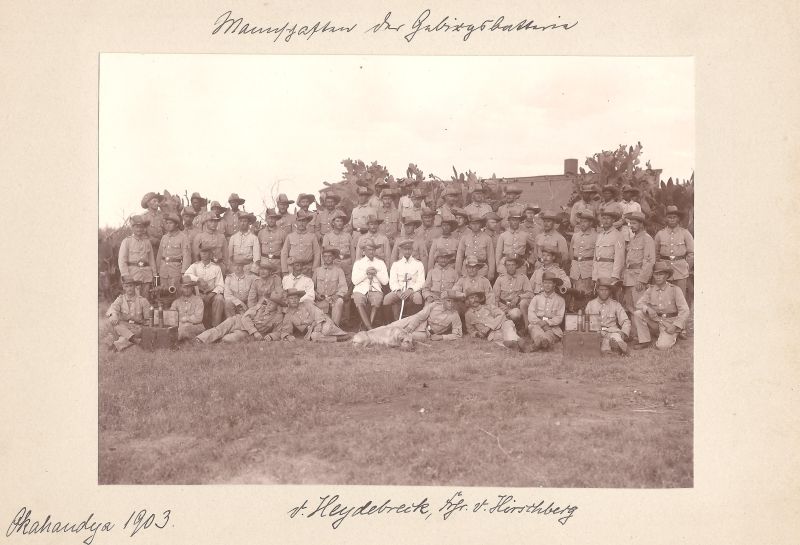 |
|
|
|
Photo
©
Karsten Herzogenrath |
|
|
|
This is a photograph of
the Mountain Gun Battery of the South West African Schutztruppe
taken in Okahandja in 1903. The unit appears fairly typically
dressed, mostly in the 1896
Schutztruppe Khaki Uniform piped in blue and the grey
Südwester Hat with hatband and
edging also in blue for South West Africa. Close examination reveals
some interesting insignia and details.
|
|
|
|
|
|
|
|
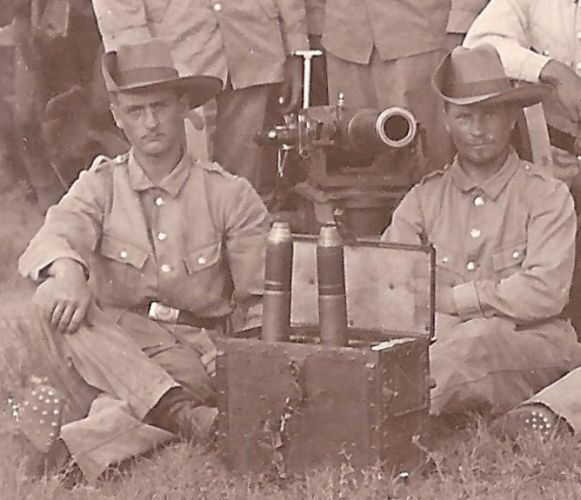 |
|
A close up of the photograph showing two gunners, a mountain
gun and a pair of shells standing on an ammunition box.
As described above they wear
Südwester hats and 1896 khaki uniforms. Note that while most of
the Schutztruppe of South West Africa were mounted infantry and
wore the unique equipment pattern including ammunition pouches,
these artillerymen are wearing brown leather belts with imperial
other ranks belt buckles. |
|
|
|
|
|
|
|
|
| Two NCOs. The one
on the left wears the single white metallic lace chevron of an
Unteroffizier on his upper left arm, while the one of the right
has the single collar button of a Gefreiter.
What is most curious here is the
crossed cannon with flaming grenade insignia worn on the upper
left arm of the Gefreiter. I have have never seen the same
insignia in another unit, not in period illustrations or uniform
regulations. It may possibly be a locally produced version of
the gun layer's insignia (see
Specialist Insignia Page).
I have no idea what colour it may have been made in.
Note that the gunner in the
photograph below is wearing another gun layer badge. Especially
note that this badge appears to be quite different in shape,
with shorter gun barrels and a more decorated grenade flame.
This leads one to conclude that they may have been locally made
rather than massed produced in Germany. |
|
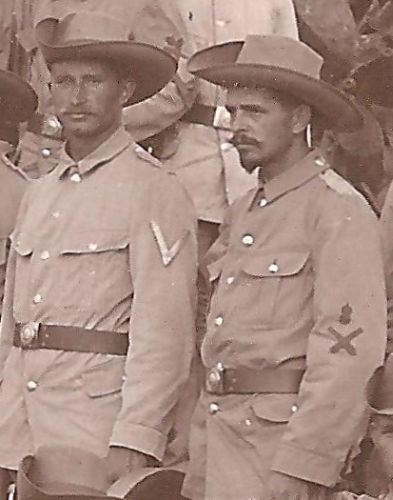 |
|
|
|
|
|
|
|
|
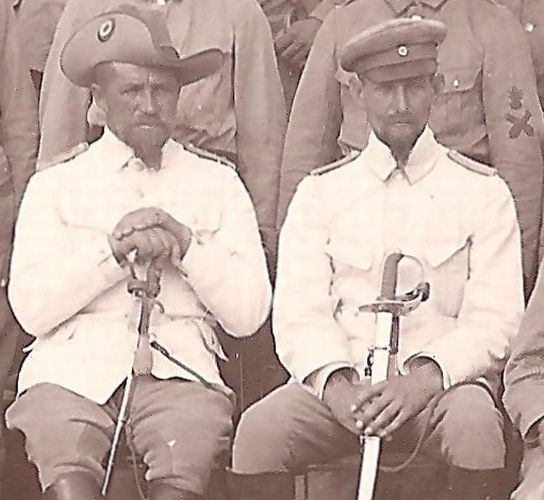 |
|
The two officers,
Joachim von Heydebreck on the left and Freiherr von Hirschberg
on the right. Both wear white 1896 Schutztruppe Uniforms with
blue piping. This is curious as although these white uniforms
were authorised in 1896 for the Schutztruppe in East Africa and
Cameroon, they were not authorised for use in South West Africa
until 1913. This is not the only period photograph to show
Schutztruppe officers in South West Africa wearing the uniform
prior to 1913. Both officers carry curved artillery swords. It
appears that Von Heydebreck's has the standard grip of an other
ranks artillery sword while von Hirschberg has the hilt of an
officers sword. Von Heydebreck wears the Südwester hat, while
von Hirschberg wears the corduroy peaked cap with hatband in
blue for South West Africa and a small imperial cockade. Note
the officers shoulder straps. Neither shows their exact rank
clearly in this photograph. They wear khaki riding breeches and
leather gaiters with short leather boots. |
|
|
|
|
|
|
|
|
| Two more gunners.
Note the one on the left is wearing musicians swallows nests in
blue with white lace. |
|
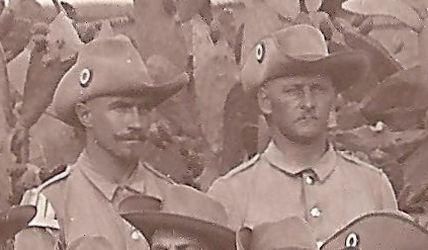 |
|
|
|
|
|
|
|
|
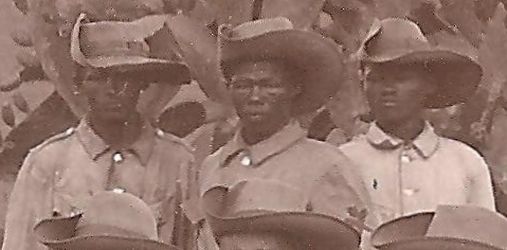 |
|
Three
African Auxiliaries seen on the top right side of the
photograph. Another three can be seen on the other side. They
wear the same uniform as their German counterparts. One has
shoulder straps while the other two do not. Note that one also
wears the same gun layer insignia as noted on some of the German
gunners. |
|
|
|
|
|
|
|
|
Joachim von Heydebreck (1861-1914) was
the son of Generalleutnant Hennig von Heydenbreck, born in Schwedt
in Brandenburg. He served in the 2nd Prussian Guard Field Artillery
Regt ("2. Garde-Feldartillerie Regiment") and was promoted to
Premier Lieutenant in 1893. In 1896 he transferred to the
Schutztruppe for South West Africa He served throughout the Herero
and Nama Rebellions. In 1907 he returned to Germany to marry Ruth
von Werder, then returned to South West Africa. In 1911 he became
deputy commander and then in 1912 commander of the South West
African Schutztruppe. On the outbreak of the First World War he
organised the mobilisation of German forces and defence of the
colony's borders including the defeat of South African forces at the
Battle of Sandfontein in September 1914. Two months later he was
mortally wounded in a accident involving the test firing of a rifle
grenade.
Recommend External Link -
Schwedt.eu |
|
|
|
|
|
|
|
Please respect the
generosity of
Karsten Herzogenrath in sharing this photograph with us by not reproducing it
without prior permission. |
|
|
|
|
|